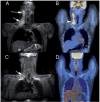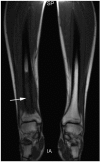Imaging 'the lost tribe': a review of adolescent cancer imaging. Part 1
- PMID: 19933020
- PMCID: PMC2792084
- DOI: 10.1102/1470-7330.2009.0012
Imaging 'the lost tribe': a review of adolescent cancer imaging. Part 1
Abstract
Although a small proportion of all cancer registrations, malignancy in adolescence and young adulthood remains the most common natural cause of death in this age group. Advances in the management and outcomes of childhood cancer have not been matched within the adolescent population, with increasing incidence and poorer survival seen amongst teenagers with cancer compared with other populations. There have been increasing moves towards specific adolescent oncology centres, with the aim of centralizing expertise, however, 'adolescent imaging' does not exist as a specialty in the same way that paediatric imaging does, with responsibility for imaging adolescent patients sometimes falling to paediatric radiologists and sometimes to 'adult' radiologists, usually with a specific interest in a tumour type or body system. In this article, imaging of the more common malignancies, encountered in adolescent patients is reviewed. Complications of treatment are reviewed in another article to give an overview of adolescent oncology imaging practice.
Figures








Similar articles
-
Imaging studies for germ cell tumors.Hematol Oncol Clin North Am. 2011 Jun;25(3):487-502, vii. doi: 10.1016/j.hoc.2011.03.014. Hematol Oncol Clin North Am. 2011. PMID: 21570604 Review.
-
Recent advances in imaging of male reproductive tract malignancies.Cancer Treat Res. 2008;143:331-64. doi: 10.1007/978-0-387-75587-8_14. Cancer Treat Res. 2008. PMID: 18619225 Review. No abstract available.
-
Performance Characteristics of Clinical Staging Modalities for Early Stage Testicular Germ Cell Tumors: A Systematic Review.J Urol. 2020 May;203(5):894-901. doi: 10.1097/JU.0000000000000594. Epub 2020 Oct 14. J Urol. 2020. PMID: 31609176
-
Leukemia and lymphoma.Radiol Clin North Am. 2011 Jul;49(4):767-97, vii. doi: 10.1016/j.rcl.2011.05.004. Epub 2011 Jun 25. Radiol Clin North Am. 2011. PMID: 21807173 Review.
-
Contemporary imaging for thyroid cancer.Surg Oncol Clin N Am. 2007 Apr;16(2):431-45. doi: 10.1016/j.soc.2007.03.009. Surg Oncol Clin N Am. 2007. PMID: 17560521 Review.
References
-
- National Collaborating Centre for Cancer. London (UK): National Institute for Health and Clinical Excellence (NICE); 2005. Improving outcomes in children and young people with cancer; p. 194.
-
- Bleyer WA, Montello M, Budd T, Kelahan A, Ries L. US cancer incidence, mortality and survival: young adults are lagging further behind. Proc Am Soc Clin Oncol. 2002;21:389.
-
- Stiller C. Epidemiology of cancer in adolescents. Med Pediatr Oncol. 2002;39:149–55. doi:10.1002/mpo.10142. PMid:12210442. - DOI - PubMed
-
- Ries LAG, Eisner MP, Kosary CL, et al. SEER cancer statistics review, 1973–1998. Bethesda, MD: National Cancer Institute; 2001.
-
- Cotterill SJ, Parker L, Malcolm AJ, Reid M, More L, Craft AW. Incidence and survival for cancer in children and young adults in the North of England, 1968–1995: a report from the Northern Region Young Persons’ Malignant Disease Registry. Br J Cancer. 2000;83:397–403. doi:10.1054/bjoc.2000.1313. PMid:10917558. - DOI - PMC - PubMed
Publication types
MeSH terms
LinkOut - more resources
Full Text Sources
Medical
